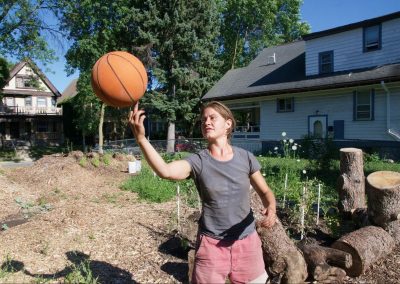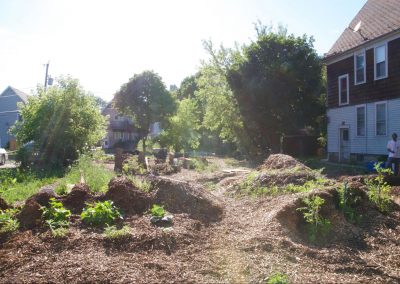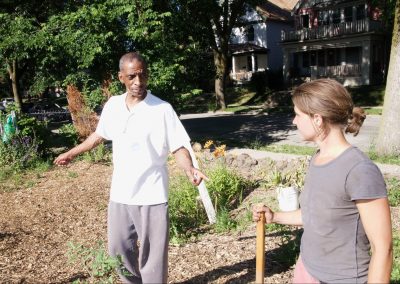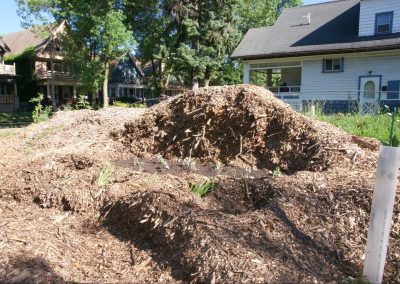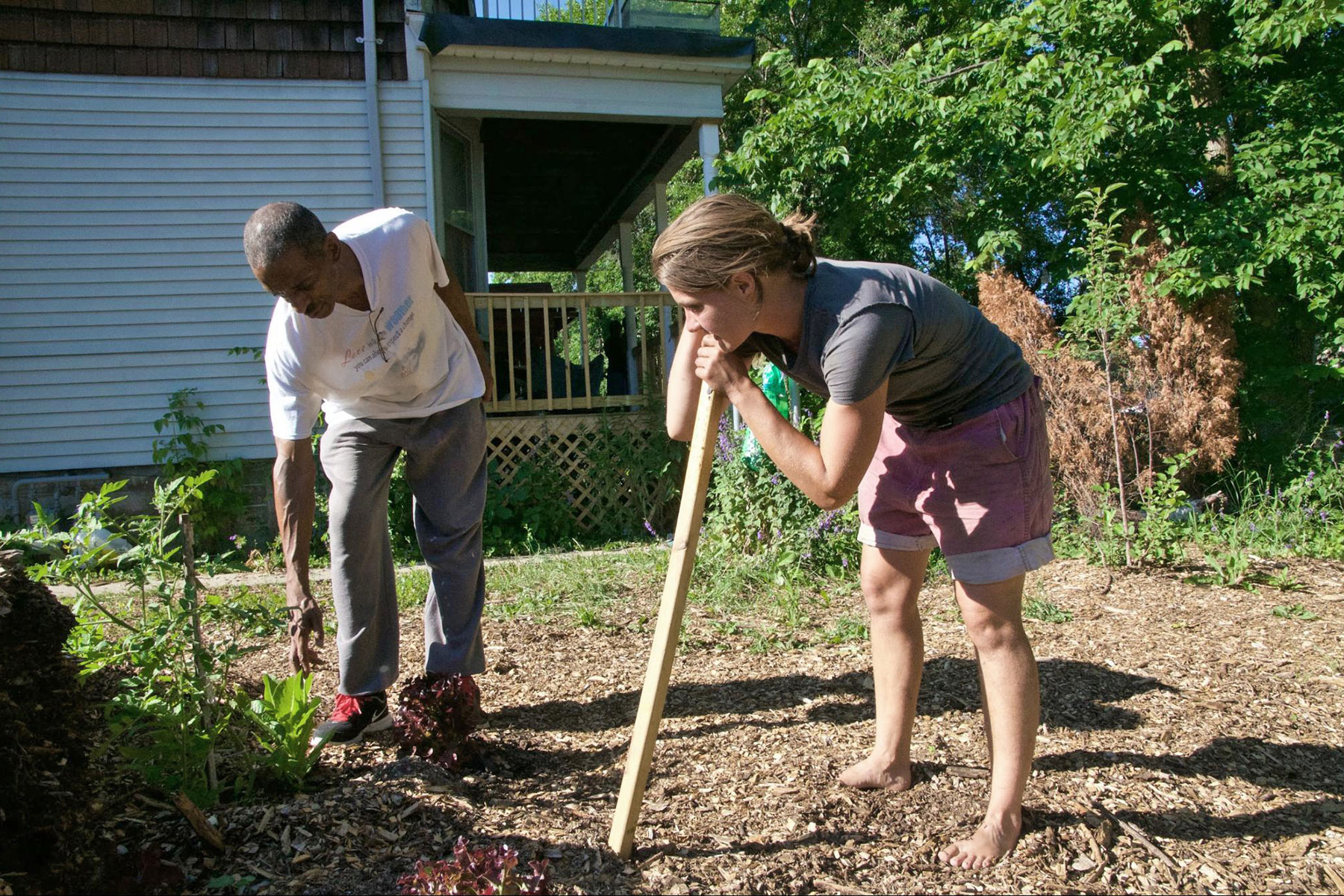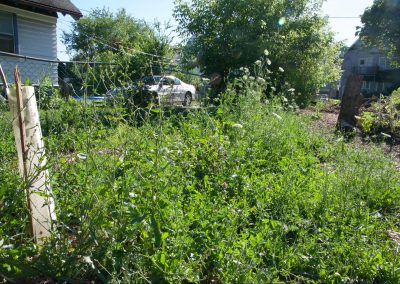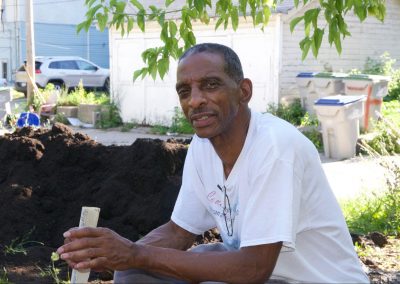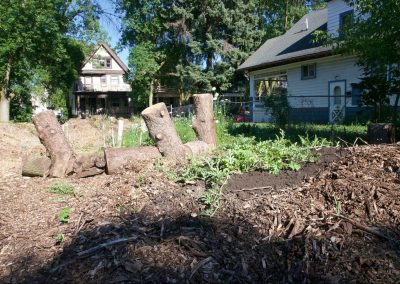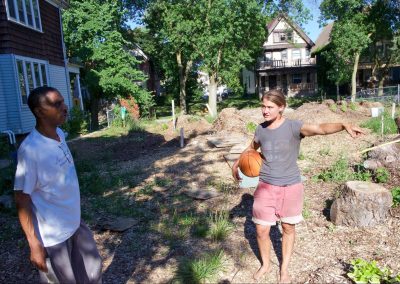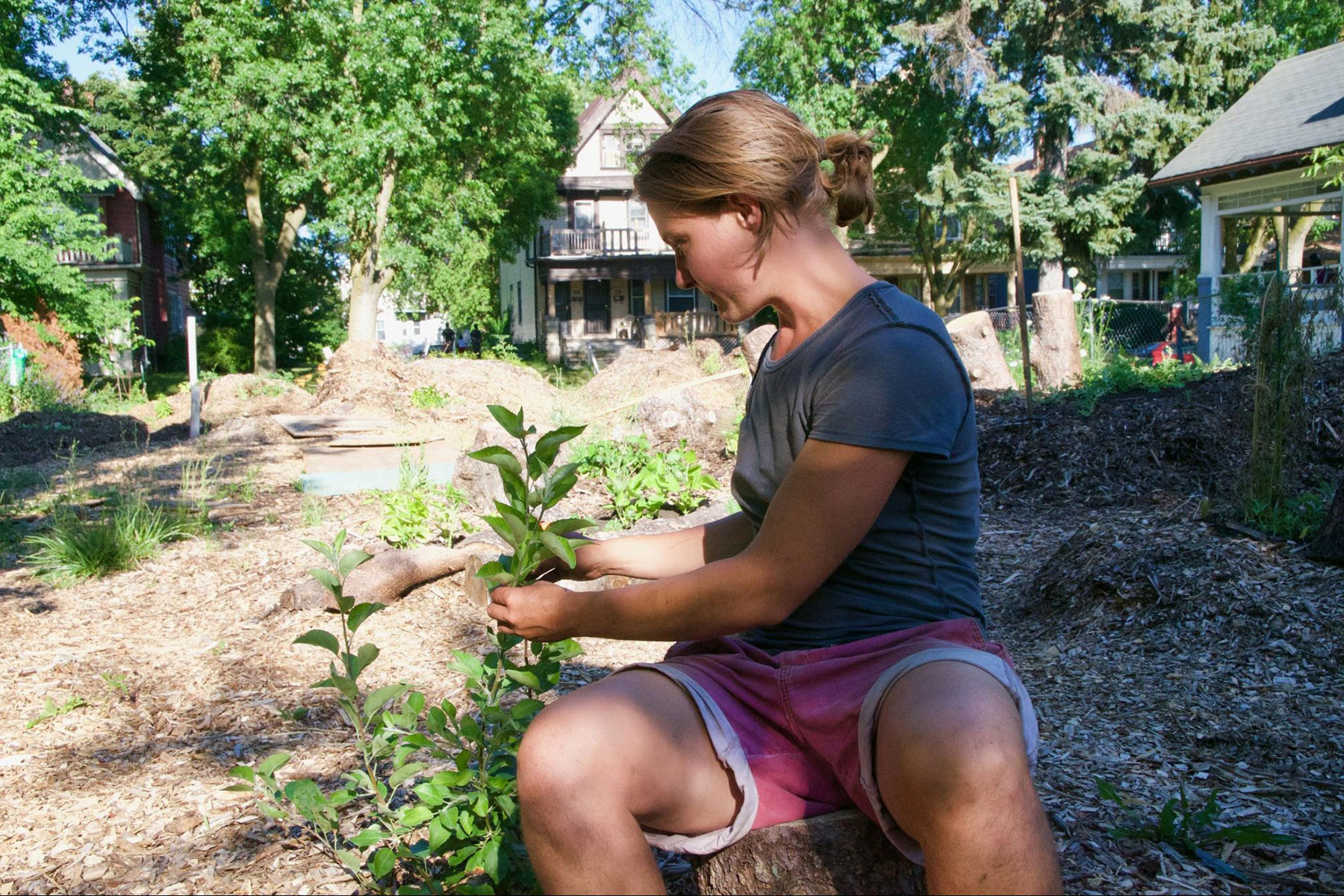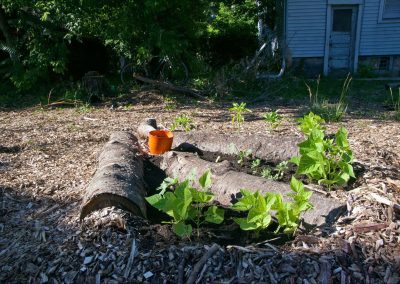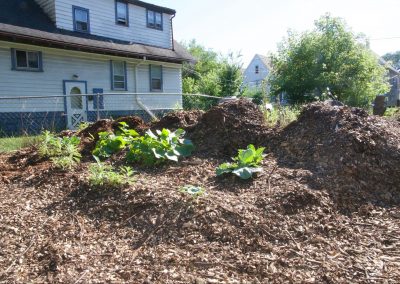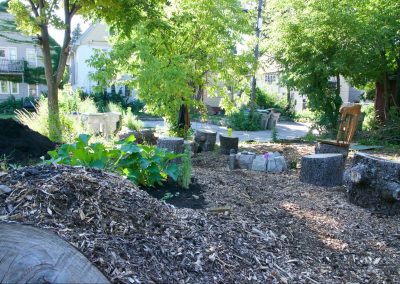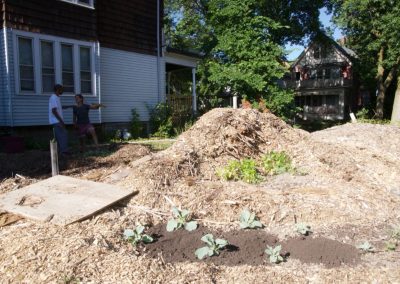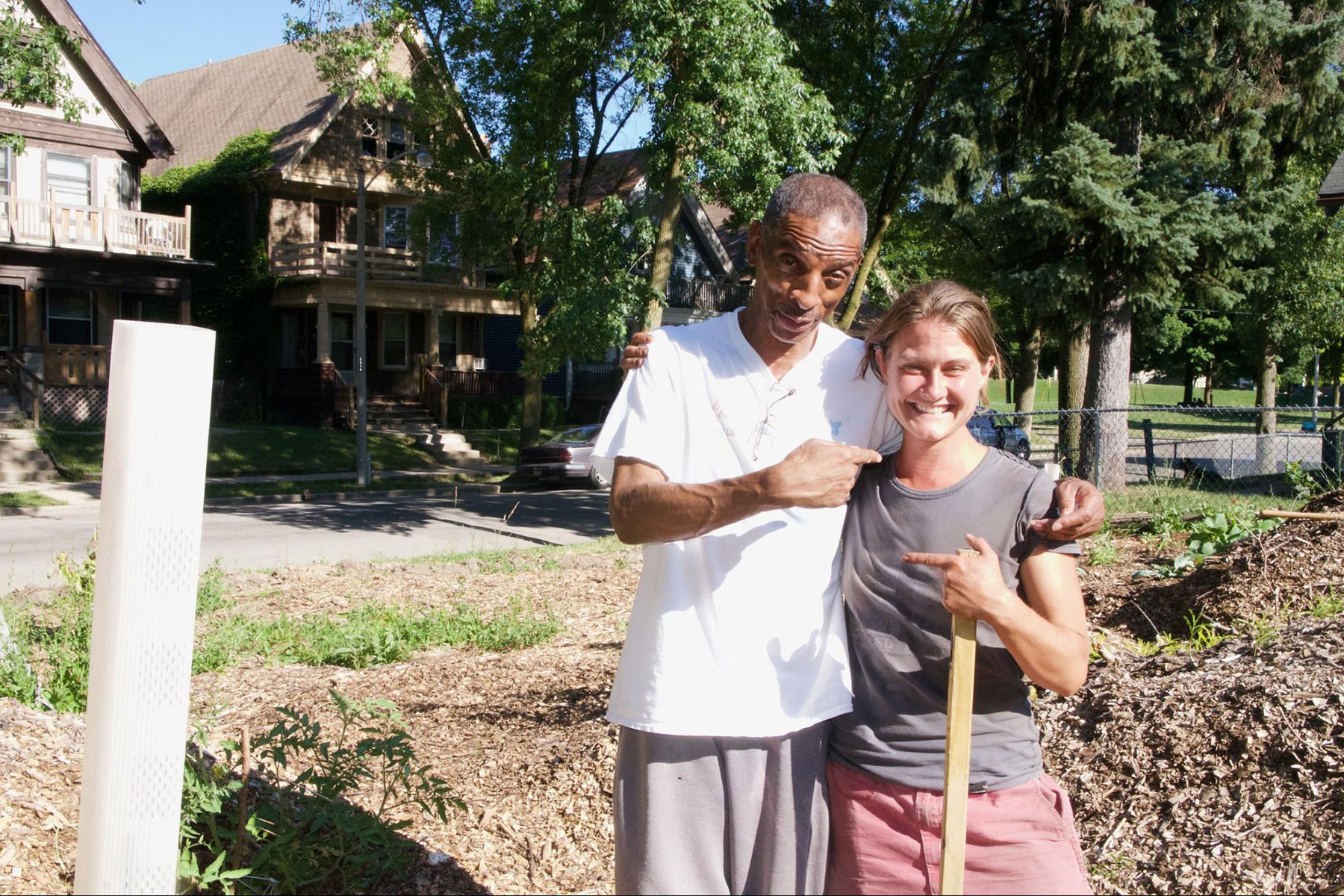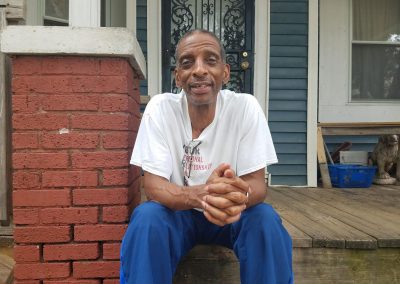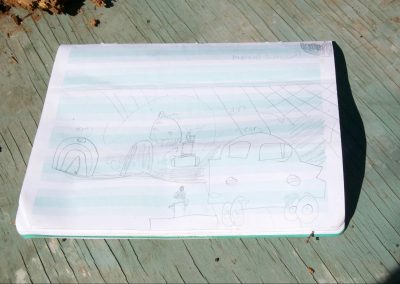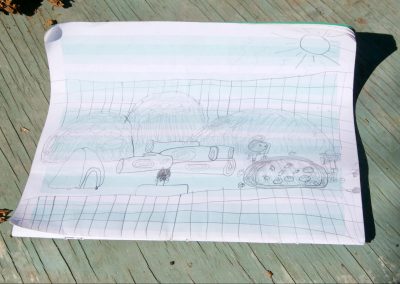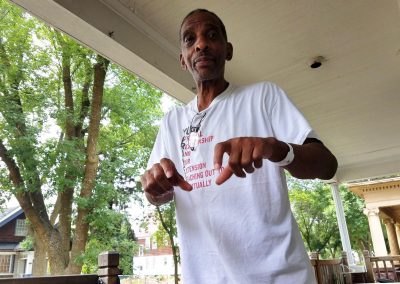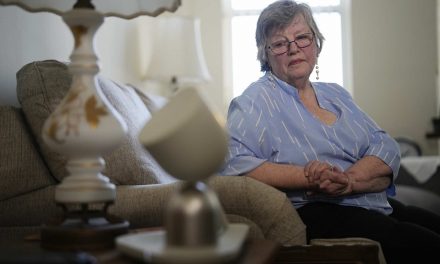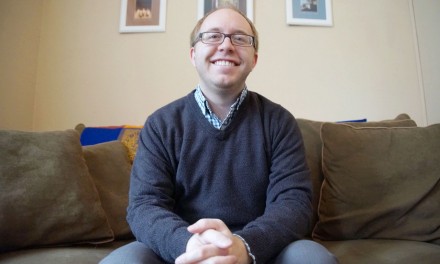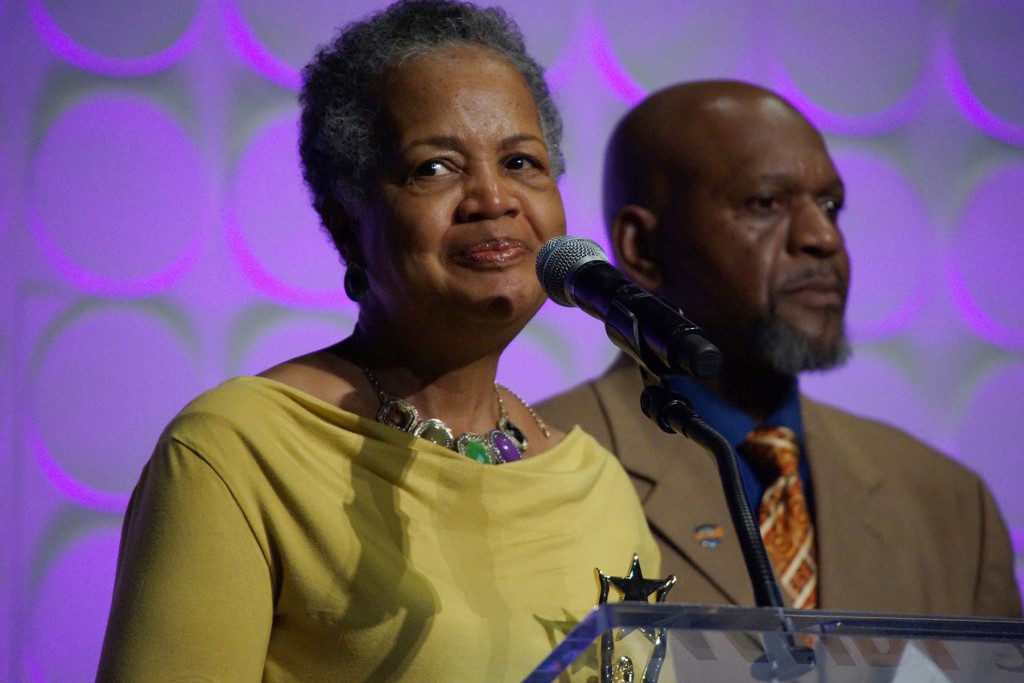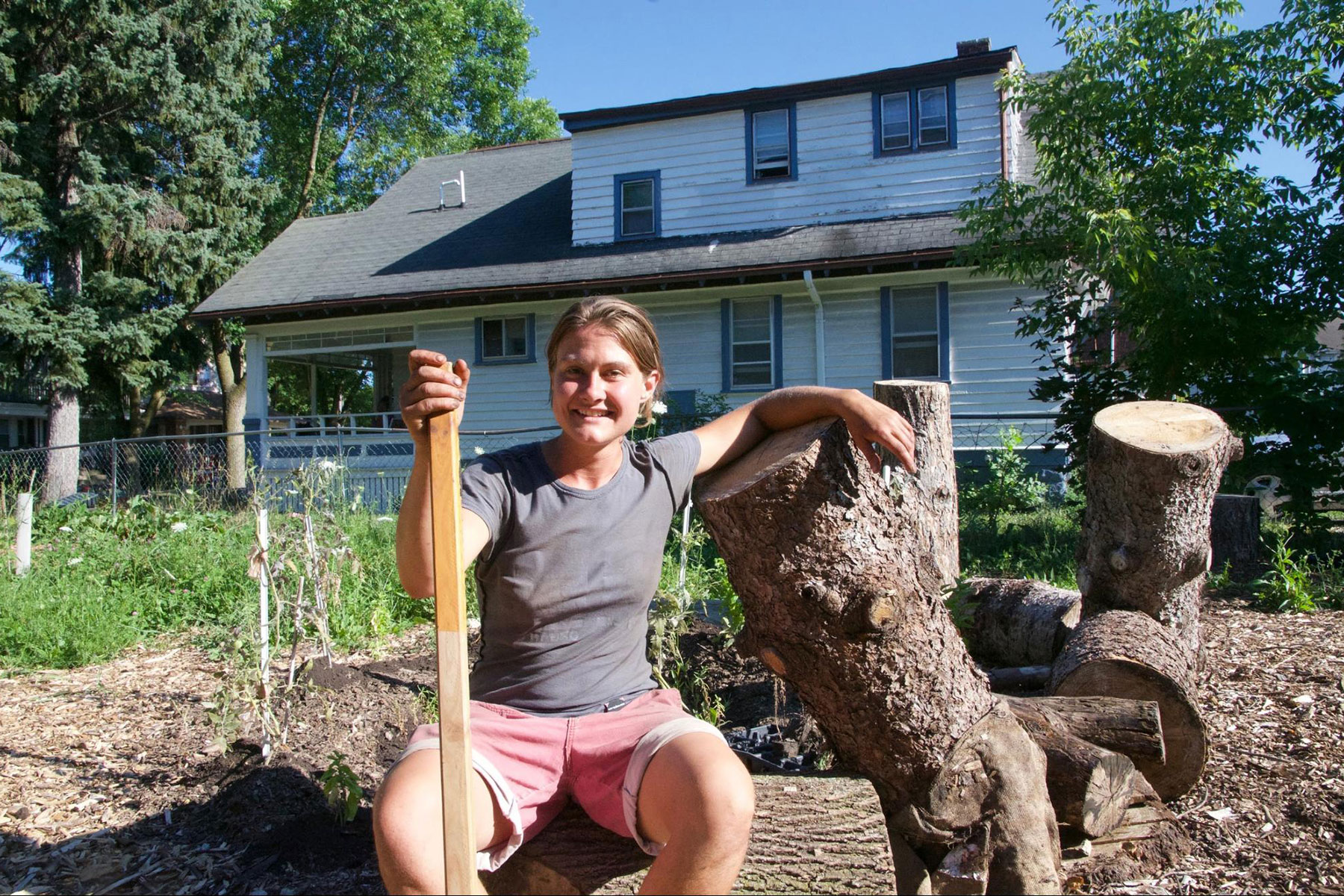
Dominic Inouye’s column for the Milwaukee Independent has been exploring the nature of walking as a social practice, the human dimensions of street photography, and the activation of public spaces.
“Would you sell homemade muffins if I made them? What about fresh fruits and vegetables?”
Aware of the limited selection of healthy food options at the Jones Smoke Shop & Grocery, Emily Breffle asked Mrs. Jones, on a whim, whether she would consider some new items at the shop. To her surprise, Mrs. Jones said yes. Secretly, Emily just wanted an excuse to bake and garden.
It was still winter the next time Emily popped into the grocery store. This time, Mrs. Jones informed her that she had a vacant lot that might be good for growing food, three doors north of Butterfly Park at 38th & Meinecke. This planted a seed in Emily’s brain and the two kept up the conversation throughout the next few months. By the spring, Mrs. Jones and her husband were ready to sell the land and asked Emily to name a price. Not knowing how much a vacant lot in Milwaukee was worth, she pitched $2,500. As the reality of now having to acquire the money set in, Emily, nonplussed, exclaimed, “I’ll get it! Just wait.” She considered selling her car, but ended up becoming a long-term 2nd grade substitute teacher for a dear friend of hers who, sadly, was undergoing chemotherapy.
Originally from Denver, Emily now found herself in Milwaukee, subbing for Milwaukee Public Schools, getting her educational feet wet and immersing herself in the lives of her students. For awhile, she lived in Washington Heights and often commuted along North Avenue to get to her schools. Thus, in the winter of 2017, she found herself at Jones Smoke Shop & Grocery at 46th and North, ostensibly for, of all things, rolling papers, not muffins or fresh produce.
Emily saved the money, and in July last year purchased the property, nestled between a house and duplex in the Sherman Park neighborhood. Drawing upon her background in sustainable growing techniques, she smothered the lot in leaves and wood chips that she acquired for free online, and planted her inaugural experiments: raspberries and rhubarb, a rose bush, and medicinal lovage and comfrey. Interested mainly in perennial systems, Emily wanted to see how these plants took in the wood chip composition, which, she hoped, would begin to decompose underneath and eventually turn into fertile soil. The perennials did well during the first summer season, a good first sign. At least Emily knew that she had made a good decision and that the land had potential.
After that first growing season, Emily found herself back in the mountains of Colorado again during the winter, then returned at the beginning of this past June. She had already ordered more free wood chips and upon her arrival at her plot she was greeted with a veritable mountain range. It was these piles of wood chips that I encountered on a Jane’s Walk through the neighborhood in May, led by Camille Mays of the Sherman Park Community Association and other community members. I remember Camille’s initial incredulity that a vacant lot in her neighborhood would have so many wood chips in it. No one from the neighborhood seemed to know who owned the property or what was to happen with all those wood chips. All we saw was yet another vacant, unused lot.
However, when Camille and I met at Butterfly Park a few weeks later to plan a summer community celebration, I noticed activity in the wood chip lot and walked over to investigate, waving hello to a group of kids perched on the corner porch and another group of kids sitting on a car on the shady side of the street. Music pumped from the car speaker. What I encountered surprised me: a young white woman in shorts and boots, digging into a mound of wood chips, hot from the sun. The random mountains of wood chips I had seen before had been transformed into artfully arranged mounds with pockets of soil carved into them, hosting vegetables and herbs at various stages of growth. Toward the back of the lot, a small tent.
After introducing myself and expressing my joy at seeing the lot transformed so, sharing about the walk that Camille and I had taken past the lot the month before, I admitted with a little shame my initial prejudices upon seeing her: Why is a white woman growing vegetables in a predominantly black neighborhood? Why is she living in a tent? Is this safe for anyone, let alone a white woman? I was fully aware of the inanity of my thoughts, an immediate and worrisome confluence of race and gender and gentrification.
But I really wanted to understand the dynamics involved in her move to the block. Thankfully, she understood where I was coming from and humbled me: “I knew it was risky, not because I was a woman or because of the neighborhood but because, well, I’m a crazy motherf*cker with a tent. You know what I mean? The first two weeks, however, were splendid. The whole neighborhood was looking out for me, coming to check up on my progress and to check up on me. I felt at home in the loving arms of my new neighbors.”
Embarrassed that my first thoughts focused on her color and gender, I swiftly refocused my attention to something else I did not understand: the garden possessed no traditional rows of vegetables. Instead, some vegetables, still diminutive, grew in patches of soil in the wood chip mounds, other low vegetables encircled a taller one, some grew in logs, others next to patches of what, as Emily confirmed, were naturally occurring weeds.
As she gave me an impromptu tour of the garden, explaining as best she could for me, this stranger, about her experiment in creating an urban food forest, about perennial systems and sustainable ecosystems, an older black man walked in from the sidewalk and inspected the healthy rhubarb and comfrey, and Camille found me and began her own friendly inquiry of Emily. If Camille shared the same first impressions that I had had, she didn’t say. But it didn’t matter.
The older man, named Nick Freeman, affirmed his support for Emily’s endeavors (in fact, it turns out that he was one of the first people that Emily befriended when she moved in) and Camille’s eyes widened as she walked the wood chip paths between the wood chip mounds, seeing the power and the potential of a space like this. She immediately began one of her well-known Facebook Live broadcasts, announcing the presence of this new oasis. This was no ordinary garden and Emily was no ordinary gardener, outsider or not.
I had to wait a few weeks after our first encounter to meet with Emily again. She had to travel back to Colorado to tie up loose ends. When we sat again in her garden on makeshift log seats, she dug her bare toes into the wood chips and told me about some of her past experiences. After high school, Emily served as an army medic for four years. In 2013, she received a bachelor’s degree in Sustainable Living from the Maharishi University of Management, an accredited non-profit university in Fairfield, Iowa, that believes “we must connect with our own inner nature and take action” if we are to creatively address the sustainability challenges of our current and future generations. She even did a stint on the Sailing Vessel Denis Sullivan in October 2017.
She eventually brought her service-oriented care for people and the environment to her work as a substitute teacher. “I have been in so many neighborhoods in Milwaukee. They’re all different and all beautiful, and there’s good and bad in all. Subbing highlighted for me, though, how much we need to heal segregation. Cultures are isolated from each other, yet we’re still living in the same city.” One of her solutions is to get people “to have a relationship with the earth,” which is something she struggled with as a teacher.
While not in the position as a substitute to start new or innovative programs, she nonetheless dreamed of offering children a relationship with their environment. As might be expected, she found herself struggling with the constraints of public education–really, any traditional educational system–which she deems “tyrannical.”
As we talked, she kept lifting handfuls of chips, which are finally breaking down the way they should, as she remarked, “It’s so hard to do anything of real value. School is such a weird place to send your kids for seven hours. I know it’s necessary, a good thing, but school buildings, the systems–all that is so separated from the earth. These wood chips are the strange gift that I’ve asked from the universe, and this garden brings out the mad scientist in me at the same time it makes me feel grounded. I love sculpting things, like massage therapy, the pushing and pulling. It’s the same thing with the earth. I shape it.”
We had been sitting in the back of the lot, protected from the heat, glare, and potential disturbances during our interview. Despite this, six children who have befriended Emily shuffled over. Ianna (10 years old), Elijah (13), Aye’janaye (13), and Khamari (15) live in the duplex next door. They are joined by their upstairs neighbor Stephen (6), who tells me that he loves planting stuff with Emily, and a girl who lives on the corner named Teionna (11), who works for Groundwork’s Young Farmers program at 28th & Wright and loves helping Emily in the garden, moving soil around and watering the plants.
Teionna left for a minute and returned proudly with pictures she had drawn of the garden. I quickly learned, however, that the children had something other than gardening on their minds today. They bugged her incessantly to build a fire in the makeshift fire pit that another neighbor had helped build using scavenged bricks. Emily said she’d talk with their mothers later, and I added jokingly that it was only three in the afternoon. But they would have none of it. Even as I left the garden later that day, the girls sneakily advised me to put in a good word for them with Emily. Even if the bonfire didn’t happen that evening, one thing was clear: Emily was still a teacher, but this time the floors of her school were wood chips.
She sees her work in the garden as “one big science experiment.” Even though she got her degree and her permaculture certification in college, before she bought the lot from Mrs. Jones it had been a long time since she had done any real permaculture work, an agricultural design process that creates sustainable, self-sufficient ecosystems that mimic those found in nature.
Her interest in permaculture was restimulated last August when she won an auction item at Alice’s Garden: a design course with local permaculturalist Barbara Richards, herself a retired Montessori public school educator and returned Peace Corps volunteer. “We don’t have a sustainable ecosystem,” Emily says. “For that matter, neither do we have sustainable relationships, sustainable institutions.”
For Emily, her science experiment is not just about where to plant the zucchini and bean sprouts, whether or not the two pecan trees and the two pear trees will grow in Milwaukee sun, figuring out how to grow okra, or arguing with Nick about whether to plant in rows or, as she has done, in mounds of wood chips and soil or in buried logs that will eventually rot and provide natural nutrients (a process called hugelkultur).
It is about establishing a nurturing space in the middle of a Milwaukee neighborhood that has its share of challenges and fostering ownership of the planning, labor, and the fruits of the labor. It’s about creating relationships and building trust, about empowering ten-year-old Ianna and the much older Nick Freeman, who has lived in a house directly across from Emily’s lot for thirty seven years.
According to Nick, “What Emily wants is to have all the neighbors eventually share the food. I want to be able to put a table of vegetable samplers out so everyone can get a sense of what’s possible here.” As I sat with Nick on his porch this July, he added, “You can really better a bad neighborhood by doing something more constructive and keeping attention on helping each other instead of speeding, littering, and taking no safety precautions. If you’re doing that, it’s ignorant.” Speaking of the ecosystem of his neighborhood, he blamed the larger system, which he says “takes control of households, and children especially, and provides them with easy answers or programs instead of teaching them how to help themselves.” For him, Emily does the latter.
This is not to say that Nick doesn’t worry about Emily. “She loves everybody, cares for everybody, wants to share with everybody. Maybe she’s a little too open, though, which worries me.” He didn’t hesitate to add that “she’s a white lady in a black society,” but says that he is more worried about her generous and giving spirit, which in his mind makes her more susceptible to compromised.
In fact, the second time I met with Emily, I noticed that her tent was gone. She told me about how her tent had, in fact, been compromised: in the middle of one night, she awoke to find a strange man in her tent, with the tent rezipped, who threatening to rape and kill her. While she was able to fend him off, this experience prompted her to find other living arrangements; she now stays with friends in Riverwest.
Emily stands by her decision to purchase her plot of land in and for the neighborhood. She wonders why every place in every city can’t be a safe, fun place to live, work and play. Holding back tears, she asks, “I can hang out or live in cool parts of cities like Denver or Milwaukee and really enjoy what they have to offer, but then I wonder where all the black and brown people are.
I wonder, what if everyone made something beautiful in their neighborhood? What if every neighborhood was a hot spot? That’s one of the reasons I’m here: to be an activist for integration versus gentrification. And if I don’t get to know everyone in this neighborhood, then I shouldn’t be here.”
Emily has certainly gotten to know Nick, which makes sense. A natural storyteller, Nick, pacing and gesturing, shared with me his early experiences with farming in Ohio that have now come full circle: “When I was a kid, my mother picked tomatoes for a living back in the ‘60s. She’d make ten cents per basket. My siblings and I would help out, of course. I was probably about six or seven. How did we get paid? We got paid in tomatoes.” He smiles. “Eventually I started learning how to grow things myself, including fish. I started fishing, but not to eat them. I fished to experiment. I would catch bluegill and keep them alive all the way from the park to home, then put them in the bathtub and watch them move! I was so intrigued by them and what they did, how they did it.”
He also remembers figuring out why a particular cherry tree in his backyard flourished more than the others: it was being fertilized by the outhouse. And he even credits his interest in the natural world and the way things work to his prison job at the House of Corrections–a different part of his life. There, he skinned pigs in the slaughterhouse, a process of slitting and boiling and peeling that Nick goes into much detail to describe.
Nowadays, though, Nick is happy to consult with Emily about whether she should weed the garden or let things grow naturally, or use Miracle Grow or decomposed logs, or pick tomatoes so the neighbor kids can sample them or pick them to preserve the energy of the entire plant so more can grow. I enjoyed hearing them try to reason with each other, compromise by reminding each other that the entire operation is “one big science experiment,” then hug.
“She’s a Master Gardener,” Nick insisted, pointing at Emily.
“Naw, he’s a Master Gardener,” Emily retorted, pointing at Nick.
Despite their mutual pride in each others’ abilities, the lot is far from an urban forest – yet. But it all started with a conversation and with more conversations, between Emily and Nick, and Emily and the rest of the neighborhood, she hopes her vision will grow and flourish. In fact, she recently decided to name the urban forest “The Conversation Peace.”
I am hoping that before the first frost I will be invited to a garden bonfire with the lone woman with a tent, the resident of nearly forty years, six children–and lots and lots of wood chips.
© Photo
Dominic Inouye

